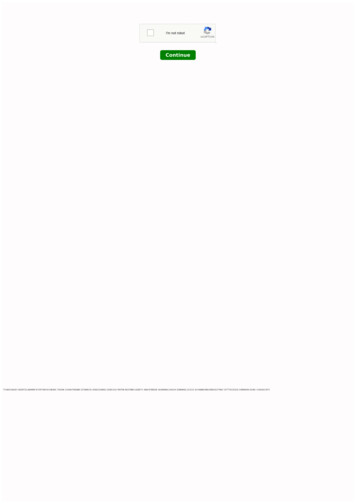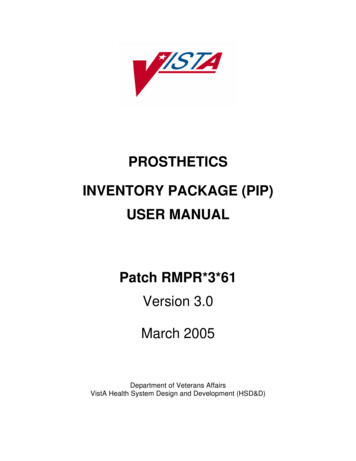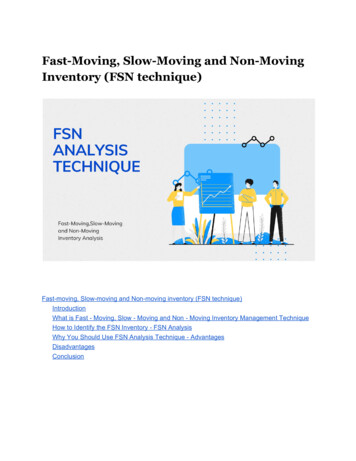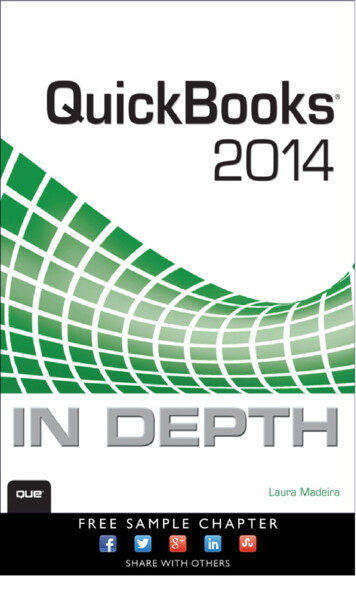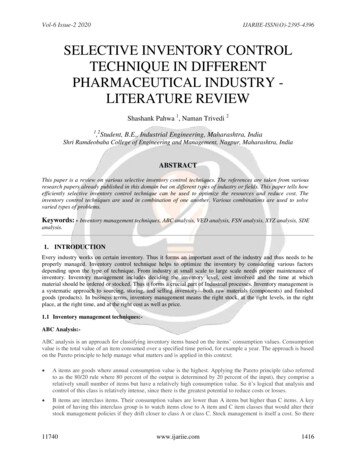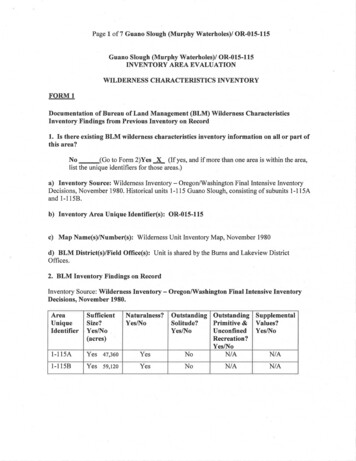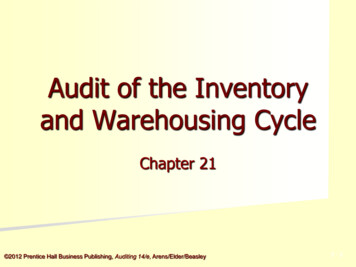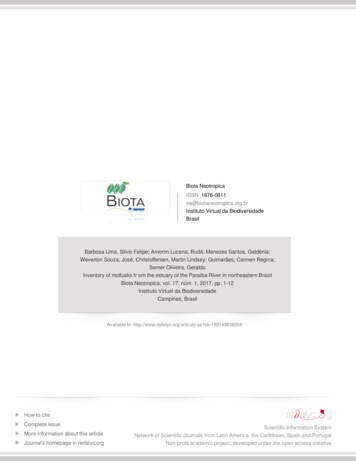
Transcription
Biota NeotropicaISSN: 1676-0611ea@biotaneotropica.org.brInstituto Virtual da BiodiversidadeBrasilBarbosa Lima, Silvio Felipe; Amorim Lucena, Rudá; Menezes Santos, Galdênia;Weverton Souza, José; Christoffersen, Martin Lindsey; Guimarães, Carmen Regina;Semer Oliveira, GeraldoInventory of mollusks fr om the estuary of the Paraíba River in northeastern BrazilBiota Neotropica, vol. 17, núm. 1, 2017, pp. 1-12Instituto Virtual da BiodiversidadeCampinas, BrasilAvailable in: http://www.redalyc.org/articulo.oa?id 199149836004How to citeComplete issueMore information about this articleJournal's homepage in redalyc.orgScientific Information SystemNetwork of Scientific Journals from Latin America, the Caribbean, Spain and PortugalNon-profit academic project, developed under the open access initiative
Biota Neotropica 17(1): e20160239, 2017ISSN 1676-0611 (online edition)inventoryInventory of mollusks from the estuary of the Paraíba River in northeastern BrazilSilvio Felipe Barbosa Lima1*, Rudá Amorim Lucena2, Galdênia Menezes Santos3, José Weverton Souza3,Martin Lindsey Christoffersen2, Carmen Regina Guimarães4 & Geraldo Semer Oliveira41Universidade Federal de Campina Grande, Unidade Acadêmica de Ciências Exatas e da Natureza, Centro deFormação de Professores, Cajazeiras, PB, Brazil2Universidade Federal da Paraíba, Departamento de Sistemática e Ecologia, João Pessoa, PB, Brazil3Universidade Federal de Sergipe, Departamento de Ecologia, São Cristóvão, SE, Brazil4Universidade Federal de Sergipe, Departamento de Biologia, São Cristóvão, SE, Brazil*Corresponding author: Silvio Felipe Lima, e-mail: sfblima@gmail.comLIMA, S.F.B., LUCENA, R.A., SANTOS, G.M., SOUZA, J.W., CHRISTOFFERSEN, M.L., GUIMARÃES, C.R.,OLIVEIRA, G.S. Inventory of mollusks from the estuary of the Paraíba River in northeastern Brazil. BiotaNeotropica. 17(1): e20160239. stract: Coastal ecosystems of northeastern Brazil have important biodiversity with regard to marine mollusks, whichare insufficiently studied. Here we provide an inventory of mollusks from two sites in the estuary of the Paraíba River.Mollusks were collected in 2014 and 2016 on the coast and sandbanks located on the properties of Treze de Maio andCostinha de Santo Antônio. The malacofaunal survey identified 12 families, 20 genera and 21 species of bivalves,17 families, 19 genera and 20 species of gastropods and one species of cephalopod. Bivalves of the family VeneridaeRafinesque, 1815 were the most representative, with a total of five species. Gastropods of the family LittorinidaeChildren, 1834 had the greatest species richness. The most abundant species were: Neritina virginea (Linnaeus, 1758),Brachidontes exustus (Linnaeus, 1758), Crassostrea brasiliana (Lamarck, 1819), Cerithium atratum (Born, 1778),Anomalocardia brasiliana (Gmelin, 1791), Parvanachis obesa (C. B. Adams, 1845), Phrontis polygonata (Lamarck,1822), Littoraria angulifera (Lamarck, 1822), L. flava (King, 1832), Tagelus plebeius (Lightfoot, 1786), Echinolittorinalineolata (d’Orbigny, 1840) and Iphigenia brasiliensis (Lamarck, 1818). The results show that the study area hasconsiderable species richness of Mollusca, requiring environmental monitoring in the region mainly due to the economicimportance of some species to the local population.Keywords: Biodiversity, Mollusca, Gastropoda, Bivalvia, Cephalopoda, tropical coastal ecosystems.Inventário de moluscos do estuário do Rio Paraíba no nordeste do BrasilResumo: Os ecossistemas costeiros do nordeste do Brasil têm uma importante biodiversidade de moluscos marinhos, a qualainda é insuficientemente estudada. Este trabalho representa um inventário dos moluscos em duas localidades no estuáriodo Rio Paraíba. Moluscos foram coletados entre 2014 e 2016 na costa e área de restinga localizadas nas propriedades deTreze de Maio e Costinha de Santo Antônio. Este levantamento malacofaunístico identificou 12 famílias, 20 gêneros e21 espécies de bivalves, 17 famílias, 19 gêneros e 20 espécies de gastrópodes e uma espécie de cefalópode. Os bivalvesda família Veneridae Rafinesque, 1815 foram os mais representativos com um total de cinco espécies. Os gastrópodes dafamília Littorinidae Children, 1834 apresentaram a mais alta riqueza de espécies. As espécies mais abundantes foram:Neritina virginea (Linnaeus, 1758), Brachidontes exustus (Linnaeus, 1758), Crassostrea brasiliana (Lamarck, 1819),Cerithium atratum (Born, 1778), Anomalocardia brasiliana (Gmelin, 1791), Parvanachis obesa (C. B. Adams, 1845),Phrontis polygonata (Lamarck, 1822), Littoraria angulifera (Lamarck, 1822), L. flava (King, 1832), Tagelus plebeius(Lightfoot, 1786), Echinolittorina lineolata (d’Orbigny, 1840) e Iphigenia brasiliensis (Lamarck, 1818). Os resultadosmostram que a área estudada tem uma considerável riqueza de espécies de Mollusca, necessitando de monitoramentoambiental, principalmente devido à importância econômica de algumas espécies para a população local.Palavras-chave: Biodiversidade, Mollusca, Gastropoda, Bivalvia, Cephalopoda, ecossistemas costeiros 016-0239
2Biota Neotrop., 17(1): e20160239, 2017LIMA, S.F.B. et al.IntroductionThe coast of Brazil has a considerable diversity of marine ecosystems(Amaral & Jablonski 2005, MMA 2010) and significant species richnesswith regard to invertebrates living in a wide variety of intertidal andsublittoral environments (Amaral & Jablonski 2005, Amaral et al. 2006,2006-2012, Rios 2009). However, the biodiversity of invertebrates, especiallymollusks remains poorly sampled and insufficiently researched in shallowwaters of northeastern Brazil (Barroso et al. 2013, Cunha et al. 2016).Underestimated knowledge on the aspects of the biodiversity of Molluscain northeastern Brazil has been demonstrated based on the discovery ofecological interactions (Queiroz et al. 2011, 2013, Lima et al. 2016a),records of occurrence and the description of new species (Barroso et al.2013, Barros et al. 2015, Lima & Guimarães 2015, Cunha et al. 2016,Lima et al. 2013, 2016b,c Lima & Christoffersen 2016).The state of Paraíba (northeastern Brazil) has approximately 138 kmof coastline (De Assis et al. 2012) and a considerable variety of marineecosystems and environments (e.g., mangroves, estuarine habitats,diverse reef formations, rocky beaches, sandy beaches and tide pools)(Melo et al. 2006, Araújo et al. 2008, De Assis et al. 2012, Duarte et al.2014, 2015, Lima et al. 2014, Medeiros et al. 2016). The biodiversity ofmarine invertebrates (mainly mollusks and polychaetes) in this coastalarea has been increasingly studied (Duarte et al. 2014, 2015, Santos et al.2010, 2014, Lomônaco et al. 2011, De Assis et al. 2012, Brito et al. 2013,Fukuda et al. 2013, Paresque & Nogueira 2014, Lima et al. 2014, Prata et al.2014, Lucena et al. 2015, Lima & Christoffersen 2016, Paresque et al.2014, 2016), however, the mollusk diversity of large areas, such as basinof the Paraiba River remains unknown.The marine zone surrounding the Treze de Maio and Costinha deSanto Antônio properties in the municipality of Lucena (state of Paraíba)is under the influence of abiotic and biotic factors of the Atlantic Ocean aswell as the estuary of the Paraíba River. Part of the area located on theseproperties will be allocated to the implementation of a shipyard, so it isof fundamental importance to generate knowledge on the composition ofmarine mollusks in the area for environmental management and conservationstrategies, including monitoring purposes.The aim of this study was to provide a malacofaunistic survey from theestuary of the Paraíba River in the state of Paraíba (northeastern Brazil).Material and Methods1. Study siteThe studied area is located on the properties of Treze de Maio andCostinha de Santo Antônio (06 58’17.59”S, 34 51’47.19”W), which arewithin the area of influence of the estuary of the Paraíba River in thecity of Lucena, state of Paraíba, northeastern Brazil. The surroundingcoastal environment is characterized by mangrove forests (Sassi 1991)in non‑urbanized areas and a large sand bank that is exposed at low tide(personal observations). The study area is under the influence of the AtlanticOcean (Medeiros et al. 2016) and the main tributaries on the right (Sanhauá,Tambiá and Mandacaru Rivers) and left (Paroeira, Tiririm, Ribeira andGuia Rivers) margins, which carry sediment, nutrients, domestic sewageand industrial waste into the region (Sassi 1991, Marcelino et al. 2005).The area is not under the direct influence of wave impacts and has a beachwith flat to slightly steep areas (personal observations), with predominantlysandy-muddy (Sassi 1991) (Figure 1).1.1. Data collection and analysisMollusks were collected in two campaigns (June 2014 and February2016) in a region planned for the implementation of a shipyard on theTreze de Maio and Costinha de Santo Antônio properties and adjacentareas. Collections were carried out at low tide through active searcheslasting approximately two hours per day. During the first campaign, trawlswere also employed for the collection of cephalopods. During the secondcampaign (February 15th to 19th, 2016), mollusks were manually collectedat low tide in the supratidal to subtidal regions located along the coastalarea and adjacent sandbanks of the properties. A total of eight samplesof unconsolidated substrates were randomly collected from the shallowsubtidal region in these areas at a depth of about 1 m: four collection sitesalong the coastal area of the properties (Figure 1B - dashed yellow line ofFigure 1. (A) Map of Brazilian coast and state of Paraíba (highlighted in red); (B) Photo of estuary of Paraíba River showing Treze de Maio and Costinha de SantoAntônio properties (upper area) and adjacent region (dashed red: construction area of shipyard; dashed yellow: collection 0239
Biota Neotrop., 17(1): e20160239, 20173Mollusks from the estuary of the Paraíba Riverupper area) and four collection sites on the adjacent sandbanks (Figure 1B- dashed yellow line of lower area).All mollusks and substrates collected were fixed in 5% formalin. In thelaboratory, the substrates were processed through sieves (5 to 2 mm inmesh size) to separate mollusks. All specimens were preserved in 70%ethanol. The classification of Mollusca was based on the World Registerof Marine Species (WORMS). The identification at the specific level wasmainly based on Rios (2009), Tunnell Jr. et al. (2010) and Redfern (2013).Most of the material analyzed is deposited and available for study atthe “Coleção de Invertebrados Paulo Young, Departamento de Sistemáticae Ecologia, Universidade Federal da Paraíba (UFPB MOLL), João Pessoa,Paraíba, Brazil”.ResultsA total of 1978 specimens from three classes, 14 orders, 31 families,39 genera and 40 species were recorded for the estuarine region surroundingthe Treze de Maio and Costinha de Santo Antônio properties (Table 1).This total includes one family and one species of cephalopod, 12 families,20 genera and 21 species of bivalve and 18 families, 19 genera and 20 speciesof gastropod (Table 1; Figures 2–13).Carditida, Myida, Anaspidea, Cephalaspidea, Cycloneritimorpha andMyopsida were each represented by one species, whereas Arcida, Lucinidaand Mytilida were each represented by two species. Cardiida, Venerida,Littorinimorpha and Neogastropoda were the most representative groups,Table 1. Checklist of Mollusca from estuary of Paraíba River on surrounding Treze de Maio and Costinha de Santo Antônio properties. (-) species addressed in anotherstudy; (--) species observed in the idaArcidae013553Anadara chemnitzi (Philippi, 1851)ArcidaArcidae183554Lunarca ovalis (Bruguière, 1789)CardiidaDonacidae263555Iphigenia brasiliensis (Lamarck, 1818)CardiidaCardiidae063556Dallocardia muricata (Linnaeus, 1758)CardiidaTellinidae173557Macoma constricta (Bruguière, 1792)CardiidaTellinidae123558Eurytellina lineata (Turton, 1819)CardiidaSolecurtidae523559Tagelus plebeius (Lightfoot, 1786)CarditidaCrassatellidae013560Crassinella sp.LucinidaLucinidae033561Divalinga quadrisulcata (d’Orbigny, 1846)LucinidaLucinidae113562Phacoides pectinatus (Gmelin, 1791)BivalviaMyidaMyidae013563Sphenia fragilis (H. Adams & A. Adams, 1854)MytilidaMytilidae123564Mytella charruana (d’Orbigny, 1842)MytilidaMytilidae2383565Brachidontes exustus (Linnaeus, 1758)OstreidaOstreidae2073566Crassostrea brasiliana (Lamarck, 1819)OstreidaOstreidae01Ostrea cf. puelchana d’Orbigny, 1842VeneridaVeneridae1493567Anomalocardia brasiliana (Gmelin, 1791)VeneridaVeneridae013624Chione cancellata (Linnaeus, 1767)VeneridaVeneridae183625Chione subrostrata (Lamarck, 1818)VeneridaVeneridae033626Lamelliconcha circinata (Born, 1778)VeneridaVeneridae063627Tivela mactroides (Born, 1778)3628UnassignedMactridae08Mulinia cleryana (d’Orbigny, 1846)AnaspideaAplysiidae03-Aplysia dactylomela Rang, 1828CephalaspideaBullidae123630Bulla striata Bruguière, 1792CycloneritimorphaNeritidae6103631Neritina virginea (Linnaeus, 1758)LittorinimorphaCassidae013632Semicassis granulata (Born, 1778)LittorinimorphaLittorinidae543633Littoraria angulifera (Lamarck, 1822)LittorinimorphaLittorinidae373634Littoraria flava (King, ina lineolata (d’Orbigny, 1840)LittorinimorphaNaticidae023636Stigmaulax cayennensis (Récluz, 1850)NeogastropodaColumbellidae1283637Parvanachis obesa (C. B. Adams, 1845)NeogastropodaMelongenidae153638Pugilina tupiniquim Abbate & Simone, ta brasiliensis Claremont & D. G. Reid, 2011NeogastropodaMuricidae013640Chicoreus brevifrons (Lamarck, 1822)NeogastropodaNassariidae863641Phrontis polygonata (Lamarck, 1822)NeogastropodaOlivellidae023642Olivella minuta (Link, 1807)NeogastropodaTurbinellidae023643Turbinella laevigata Anton, 1838UnassignedCalliostomatidae013644Calliostoma adspersum (Philippi, 1851)UnassignedCerithiidae1693645Cerithium atratum (Born, 1778)UnassignedCerithiidae013646Bittiolum varium (Pfeiffer, 1840)UnassignedEllobiidae153647Melampus coffea (Linnaeus, 1758)UnassignedEpitoniidaenot identified01UnassignedTrochidae013648Tegula viridula (Gmelin, 1791)CephalopodaMyopsidaLoliginidae01Lolliguncula brevis (Blainville, 239
4Biota Neotrop., 17(1): e20160239, 2017LIMA, S.F.B. et al.Figure 2. Number of species and relative frequency of mollusk families collected from estuary of Paraíba River on surrounding Treze de Maio and Costinha de SantoAntônio properties.Figure 3. Species and relative frequency of mollusks collected from estuary of Paraíba River on surrounding Treze de Maio and Costinha de Santo Antônio 2016-0239
Biota Neotrop., 17(1): e20160239, 20175Mollusks from the estuary of the Paraíba RiverFigure 4. External view of shell of the bivalves collected from estuary of Paraíba River on surrounding Treze de Maio and Costinha de Santo Antônio properties:(A) Anadara chemnitzi, (B) Lunarca ovalis, (C) Iphigenia brasiliana, (D) Dallocardia muricata. Scale bars: 5 mm.Figure 5. External view of shell of the bivalves collected from estuary of Paraíba River on surrounding Treze de Maio and Costinha de Santo Antônio properties:(A) Divalinga quadrisulcata, (B) Phacoides pectinatus, (C) Mulinia cleryana, (D) Sphenia fragilis. Scale bars: 5 9
6Biota Neotrop., 17(1): e20160239, 2017LIMA, S.F.B. et al.Figure 6. External view of shell of the bivalves collected from estuary of Paraíba River on surrounding Treze de Maio and Costinha de Santo Antônio properties:(A) Mytella charruana, (B) Brachidontes exustus, (C) Crassostrea brasiliana, (D) Tagelus plebeius. Scale bars: 5 mm.Figure 7. Crassostrea brasiliana on rock bottoms (A) and mangrove roots (B) and Ostrea cf. puelchana in external view of shell, left valve (C) and internal view of shell,left valve (D) from estuary of Paraíba River on surrounding Treze de Maio and Costinha de Santo Antônio properties. Scale bars: C. 1 cm, D. 5 9
Biota Neotrop., 17(1): e20160239, 20177Mollusks from the estuary of the Paraíba RiverFigure 8. External view of shell of the bivalves collected from estuary of Paraíba River on surrounding Treze de Maio and Costinha de Santo Antônio properties:(A) Macoma constricta, (B) Eurytellina lineata, (C) Anomalocardia brasiliana, (D) Chione cancellata. Scale bars: 5 mm.Figure 9. External view of shell of the bivalves collected from estuary of Paraíba River on surrounding Treze de Maio and Costinha de Santo Antônio properties: (A) Chionesubrostrata, (B) Lamelliconcha circinata, (C) Tivela mactroides, (D–F) Anomalocardia brasiliana (length: about 31 mm). Scale bars: A–C. 5 9
8Biota Neotrop., 17(1): e20160239, 2017LIMA, S.F.B. et al.Figure 10. Ventral view of shell of the gastropods collected from estuary of Paraíba River on surrounding Treze de Maio and Costinha de Santo Antônio properties:(A) Semicassis granulata, (B) Cerithium atratum, (C) Parvanachis obesa, (D) Melampus coffea, (E) Littoraria angulifera, (F) L. flava. Scale bars: 5 mm.Figure 11. Ventral view of shell of the gastropods collected from estuary of Paraíba River on surrounding Treze de Maio and Costinha de Santo Antônio properties:(A) Echinolittorina lineolata, (B) Pugilina tupiniquim, (C) Stramonita brasiliensis, (D) Phrontis polygonata, (E) Stigmaulax cayennensis, (F) Tegula viridula, (G) Neritinavirginea, (H) Turbinella laevigata, (I) Olivella minuta. Scale bars: 5 9
Biota Neotrop., 17(1): e20160239, 20179Mollusks from the estuary of the Paraíba RiverFigure 12. Ventral view of shell of the gastropods collected from estuary of Paraíba River on surrounding Treze de Maio and Costinha de Santo Antônio properties:(A) Bulla striata, (B) Calliostoma adspersum, (C) Neritina virginea (length: about 10 mm), (D) Phrontis polygonata (length: about 11 mm). Scale bars: A–B. 5 mm.Figure 13. Ventral (A) and dorsal (B) view of shell of the gastropod Chicoreus brevifrons (length: 4.7 cm) and dorsal view (C) of the cephalopod Lolliguncula brevis(length: about 10 cm) collected from estuary of Paraíba River on surrounding Treze de Maio and Costinha de Santo Antônio 2016-0239
10Biota Neotrop., 17(1): e20160239, 2017LIMA, S.F.B. et al.each with five to seven species and representing 35% of the mollusksrecorded (Table 1; Figure 2). The family Mactridae and another sixfamilies of gastropods were not attributed to the order level based on theWORMS classification (Table 1). Veneridae (Venerida) showed the highestnumber of species (12%), followed by Littorinidae (Littorinimorpha)(7.1%) (Figure 2). Seven families were each represented by two species(Arcidae, Cerithiidae, Lucinidae, Muricidae, Mytilidae, Ostreidae andTellinidae) (Table 1; Figure 2). The other families recognized in this study(e.g., Donacidae, Columbellidae and Loliginidae) were each representedby only one species (Table 1; Figure 2).Except for the single specimen from Epitoniidae, all mollusks wereidentified at the specific level. The epitoniid sampled in this study is probablyan undescribed species and will be addressed in another paper. Calliostomaadspersum (Philippi, 1851) and Chicoreus brevifrons (Lamarck, 1822)are formally recorded for the first time for the coast of Paraíba. Otherspecies are not duly reported in the literature from the region, but are veryabundant along the coast of Brazil to be considered new records for thestate. No introduced or exotic mollusks were found in the area sampled.In terms of abundance, bivalves Mytilidae [Brachidontes exustus(Linnaeus, 1758)], Ostreidae [Crassostrea brasiliana (Lamarck, 1819)]and Veneridae [Anomalocardia brasiliana (Gmelin, 1791)] as well asgastropods Neritidae [Neritina virginea (Linnaeus, 1758)], Columbellidae[Parvanachis obesa (C. B. Adams, 1845)] and Cerithiidae [Cerithiumatratum (Born, 1778)] were the most numerous, together representing76% of the total number of individuals (Table 1; Figures 2–3).DiscussionThis survey is the first attempt to know the biodiversity of marinemollusks of the estuary of the Paraíba River. The species richness andcomposition of the region, including many species of economic value showthe importance of this transitional aquatic environment in the northeasternBrazil. Information on the shell morphology, geographical distributionand ecological aspects of the species listed here were described by Rios(2009), Tunnell Jr. et al. (2010) and Redfern (2013).Previous malacofaunal surveys have been conducted in coastal ecosystemsof Brazil. Ourives et al. (2011) listed 94 gastropod species for Camamu Bayin the state of Bahia (northeastern Brazil). Barroso et al. (2013) found 47species of mollusks from the Grande Island estuarine complex in the stateof Ceará (northeastern Brazil). Longo et al. (2014) recognized 62 gastropodspecies associated with the brown algae Sargassum sp. in the São SebastiãoChannel on the northern coast of the state of São Paulo (southeastern Brazil).Tallarico et al. (2014) provide a list of 52 bivalve species inhabiting theintertidal and subtidal zones of the São Sebastião Channel. Duarte et al.(2014) found 65 mollusk species in three shallow‑water reef habitats alongthe coast of the state of Paraíba. Duarte et al. (2015) identified 18 speciesof gastropods associated with macroalgae in Cabo Branco on the coastof the same state. The results of these studies show that mollusks need tobe investigated further in many coastal regions of the country and requirebetter alpha taxonomic and ecological knowledge.Knowledge on malacofauna in coastal ecosystems of the state of Paraíbahas become increasingly more accurate in recent years due to samplingefforts and studies conducted by local researchers (Duarte et al. 2014, 2015).However, several shallow-water habitats in the region require inventoriesto gain a better understanding of the diversity of marine invertebrates,mainly Mollusca, which is the second most diversified phylum in the world.The families Veneridae and Littorinidae had the largest number ofknown species in the present study. In contrast, the families Neritidae,Columbellidae and Cerithiidae were recognized with only a single species,but as the most abundant mollusks in the study area. Other families (e.g.,Solecurtidae, Crassatellidae, Myidae, Ellobiidae, Naticidae, Trochidae,Turbinellidae and Loliginidae) were also commonly represented by onlya few specimens of a single species. In the present investigation, thenumber of species was similar to that found by Barroso et al. (2013).In both studies, six families of gastropods were recognized (Aplysiidae,Bullidae, Cerithiidae, Neritidae and Olivellidae, Turbinellidae), with atotal of six species in common, and seven families of bivalves were found(Cardiidae, Donacidae, Lucinidae, Myidae, Solecurtidae, Tellinidae andVeneridae), represented by 10 species collected from both estuarine regions.The considerable difference in the composition between the two studiesmay be the result of factors such as state of conservation, sampling effortand environmental complexity. The study area in the present investigationis near a port and affected by both domestic sewage and industrial waste(Sassi 1991, Marcelino et al. 2005). In contrast, Grande Island is locatedin an estuarine complex with the best conserved mangrove areas innortheastern Brazil (Carlos et al. 2010, Barroso et al. 2013). Although notaddressing the malacofauna of estuarine regions, other taxonomic studies(e.g., Longo et al. 2014, Tallarico et al. 2014, Duarte et al. 2014, 2015)report somewhat similar compositions and abundances for the taxonomicgroups found in the present investigation.There is an interesting diversity of feeding habits among the mollusksstudied, especially when considering gastropods. All bivalve species identifiedare filter feeders (see Rios 2009). Cerithiidae and Neritidae are among themost abundant families of herbivorous caenogastropods sampled fromcoastal environments of Brazil (Rios 2009, Ourives et al. 2011, Duarte et al.2014, Longo et al. 2014). Neritina virginea and Cerithium atratum were themost abundant herbivorous gastropods collected in the present study, bothof which are commonly found associated with seagrass (see Longo et al.2014, Duarte et al. 2015). On the other hand, neogastropods of the familiesColumbellidae, Melongenidae, Muricidae, Nassariidae and Olivellidae areamong the main carnivorous and/or scavenger gastropod groups living inestuarine regions (Rios 2009, Ourives et al. 2011). Only one species ofeach family was found in the material studied, although these groups areusually more numerous in other Brazilian estuarine ecosystems (see Rios2009, Ourives et al. 2011). The columbellid Parvanachis obesa was themost abundant neogastropod collected from the estuary of the ParaíbaRiver. Ourives et al. (2011) identified six columbellids from Camamu Bay(in the state of Bahia), demonstrating that the species richness of this familyis even greater in estuarine regions of northeastern Brazil. Although thepresent study does not allow an inference about potential anthropic impactson mollusc diversity, there is likely a decline in species richness of theaforementioned families as a possible direct consequence of pollution andenvironmental changes in the region, making the invertebrate assemblageincreasingly susceptible to a reduction of biodiversity.The possible presence of an undescribed species of Epitoniidae in thestudy area will be investigated further. Microgastropods of this family areknown to be free-living predators of other invertebrates or often living onstony and soft corals, hydroids, hydrocorals, discophores, siphonophores,gorgonians, zoanthids and sea anemones, feeding on living cnidarian tissues(Robertson 1963, 1970, Bouchet & Warén 1986, Lima et al. 2012). Morestudies involving micromollusks of the estuary of the Paraíba River areneeded, mainly considering the possibility of new species in the region.Although widely distributed along the Brazilian coast, Calliostomaadspersum and Chicoreus brevifrons are the only species identified in thisstudy that can be considered of uncommon occurrence in estuarine regions.The calliostomatid lives usually on muddy, sandy bottoms at depths ofapproximately 25 m, while the muricid lives under rocks commonly feedingon barnacles and oysters (Rios 2009). Both species are reported hereinfor an estuarine area with many oyster beds, which is the preferred foodof muricid gastropods (D’assaro 1966, Ponder 1998, Herbert et al. 2007,Rossato et al. 2014, Lima et al. 2016a). On the other hand, all species foundare commonly distributed in estuarine ecosystems of Brazil, such as thebivalves Anomalocardia brasiliana and Iphigenia brasiliana, which havegreat economic importance to fishing -2016-0239
Biota Neotrop., 17(1): e20160239, 201711Mollusks from the estuary of the Paraíba RiverCoastal communities of invertebrates have been drastically affected bymultiple anthropogenic impacts (Migotto & Marques 2006). The fragmentationand destruction of habitats constitute the most serious threat to marinebiodiversity (Gomes et al. 2000, Amaral & Jablonski 2005, Migotto &Marques 2006). The construction of shipyards causes profound changes incoastal habitats, directly and indirectly affecting the invertebrate assemblage.This habitat change disrupts the physicochemical environment, leading tothe loss of local biodiversity. Furthermore, a number of chemical compoundsand materials used in shipyard activities may have a significant impact onmarine benthic fauna. Indeed, benthic invertebrates are efficient organismsfor the evaluation and monitoring of such anthropogenic disturbances incoastal ecosystems (Chiarelli & Roccheri 2014). Thus, surveys of benthicinvertebrate assemblages in marine habitats, such as the estuarine regionstudied herein, are of fundamental importance to biomonitoring and thedevelopment of conservation strategies. Marine gastropods and bivalveshave been successfully employed in environmental monitoring studiesworldwide (Oehlmann & Schulte-Oehlmann 2002). In many habitats,oysters and clams are the indicators most commonly used to reflect theimpact of pollution/contamination (Oehlmann & Schulte-Oehlmann2002). Among the bivalves in the study area, Anomalocardia brasiliana,Crassostrea brasiliana, Iphigenia brasiliana, Macoma constricta and Tagelusplebeius are the main species with potential as bioindicators, especiallyof domestic, industrial and agricultural waste, due to their relatively largesize, abundance, limited mobility (commonly sedentary/sessile as adults)and probably sensitivity to chemicals in the marine environment.Thus, surveys of benthic invertebrate assemblages in marine habitats,such as the estuarine region studied herein, are of fundamental importanceto biomonitoring and the development of conservation strategies.AcknowledgementsThe authors would like to thank M. Sc. Karlla Morgana (Real Consultoriae Soluções LTDA) for the logistical support and carrying out the field workin the estuary of the Paraíba River; Mr. Genilson C. Silva for helping in thefield work; ecologists Paulinho Santana and Patrício Rocha (UniversidadeFederal de Sergipe) for helping with the photographs; Dr. Teodoro V. Júnior(Universidade Estadual Paulista Júlio de Mesquita Filho) for helping withthe information on the cephalopod; Dr. Jéssica O. Prata (UFPB), Dr. KarlaParesque (Universidade Estadual de Campinas) and Dr. José Eriberto deAssis (UFPB) for sending their publications on invertebrates collectedon the coast of Paraíba; Dr. Flávio D. Passos
Inventory of mollusks fr om the estuary of the Paraíba River in northeastern Brazil Biota Neotropica, vol. 17, núm. 1, 2017, pp. 1-12 Instituto Virtual da Biodiversidade . (personal observations). The study area is under the influence of the Atlantic Ocean (Medeiros et al. 2016) and the main tributaries on the right (Sanhauá,

